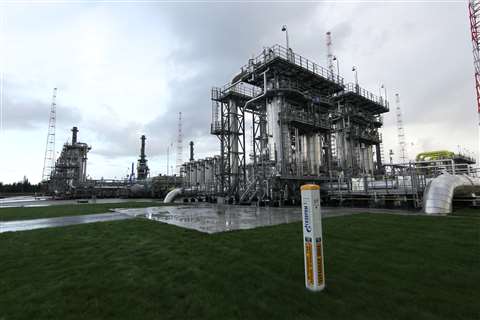Nord Stream flows below capacity amid turbine standoff
09 August 2022
 Russia’s state-owned Gazprom cut gas flows on Nord Stream to a fraction of the total capacity for Nord Stream of 5.9 Bcf/d. (Photo: Gazprom.)
Russia’s state-owned Gazprom cut gas flows on Nord Stream to a fraction of the total capacity for Nord Stream of 5.9 Bcf/d. (Photo: Gazprom.)
The Nord Stream pipeline from Russia to Germany continued to flow at roughly 20% capacity amid a dispute over the status of a turbine that had recently been returned to Europe following maintenance in Canada.
The SGT-A65 turbine is normally installed at the Portovaya compressor station in Russia but had been sent to Canada for repairs by Germany’s Siemens Energy. The turbine is one of eight aeroderivative gas turbines used at the compressor station. Six of the units have a capacity of 52 MW each, while two have a capacity of 27 MW each. There are also four back-up turbines at Portovaya aimed at ensuring the compressor station keeps running when some of the equipment goes offline for maintenance.
However, Russia’s state-owned Gazprom cut gas flows on Nord Stream to 40% of its total capacity of 5.9 Bcf/d (1.67 × 108 m3/d) in mid-June citing maintenance issues. This was followed by a 10-day shutdown for maintenance in July. Once flows restarted, they remained limited, with Gazprom saying that only one of the six main turbines at the Portovaya compressor station was operating, as well as one of the back-up turbines. According to the company, three other turbines at Portovaya also require major overhauls.
Concerns over gas supply shortages in Germany prompted the Canadian government in mid-July to allow Siemens to return the repaired turbine to Europe under a sanctions waiver. This has not resolved the issue however, and the turbine remained in Germany as of August 4, with Gazprom claiming sanctions made its return to Russia impossible.
Germany has rejected this claim, however, accusing Gazprom of not honoring its contracts and limiting supplies to Europe for political reasons.
Amid lower gas imports from Russia, energy ministers from the 27 European Union member states – except Hungary – have approved a proposal by the European Commission to reduce natural gas use across the bloc by 15% until the spring of 2023.
The proposal was unveiled as gas flows from Russia to Europe remained curtailed, because of what the Commission described as “the Kremlin’s weaponization of gas exports.”
In particular, the Nord Stream pipeline from Russia to Germany was offline when the proposals were published, and while it subsequently came back online, only 20% of its capacity was being used as of August 4.
Under the Commission’s European Gas Demand Reduction Plan, EU member states would focus on substituting gas with other fuels, as well as achieving overall energy savings across all sectors. The plan aims to safeguard supply to households and essential users such as hospitals, as well as industries considered to provide essential products and services to the economy and EU supply chains.
The 15% reduction target amounts to around six weeks of EU gas consumption based on 2021 levels. The target would be voluntary, but under the initial proposals, a mandatory gas demand reduction could have been imposed on all EU member states without consultation if there was a risk of a severe supply shortage or exceptionally high demand. However, this part of the plan received pushback from various countries and the Czech presidency of the EU Council redrafted the text so that members of the bloc would need to vote to approve any mandatory cuts. Certain other changes and exemptions were also worked into the proposals.
The amended text was more widely acceptable to EU members. A certain amount of opposition to mandatory measures remains, though, with the Polish government subsequently calling for the ability to veto binding cuts days after the plan was approved by energy ministers.
Russia’s Gazprom cuts gas supplies to Latvia
Separately, Russia’s state-owned Gazprom said it had cut off gas supplies to Latvia, after accusing the Baltic country of violating conditions of purchase. However, it did not specify what conditions had allegedly been violated.
The move came after Russia had already cut off gas supplies to Poland, Bulgaria, Finland, the Netherlands and Denmark in recent months, while flows to other European countries including Germany remained reduced.
Latvian officials said Gazprom’s move to cut off supplies would have limited impact given that the country was already planning to ban imports of Russian gas from January 1, 2023. In particular the country will prioritize imports of LNG via Lithuania’s Klaipeda terminal. However, the Lithuanian government has previously warned that Klaipeda LNG’s capacity is insufficient to meet gas demand from the whole Baltic region, which also includes Estonia.
Indeed, construction of another LNG import facility, Paldiski, in Estonia is currently underway and media reported in late July that work was on schedule to be completed by November. A floating storage and regasification unit (FSRU) is expected to be deployed soon after construction is complete. Estonia has a joint agreement with Finland to charter an FSRU from Excelerate Energy and the vessel is expected to dock wherever receiving infrastructure is available first.
STAY CONNECTED




Receive the information you need when you need it through our world-leading magazines, newsletters and daily briefings.
POWER SOURCING GUIDE
The trusted reference and buyer’s guide for 83 years
The original “desktop search engine,” guiding nearly 10,000 users in more than 90 countries it is the primary reference for specifications and details on all the components that go into engine systems.
Visit Now
CONNECT WITH THE TEAM









